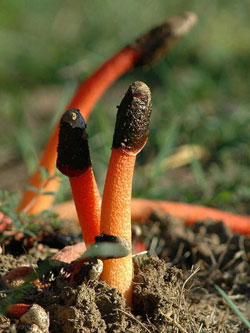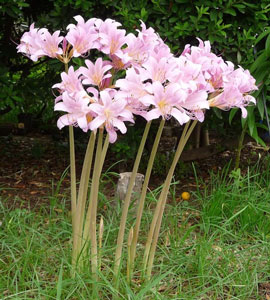
Photo Caption: Dog Stinkhorn

Photo Caption: Surprise Lilies
By Jean Ponzi
Nature’s birthday gift to me and all Leos comes in trumpeting bursts of leggy pink mid-summer bloom. Whenever I see Surprise Lilies, I cheer SURPIIIISE!!!
Yes, every time. Just ask my mate.
These are towering Allium plant family kin, a big clan, first cousins to garlic and onions. They have popped up all over our yard: in sun, shade, through dense ivy beds, and even in the scrappy part of our place that long ago was a neighborhood dump. But who dug Lycoris squamigera bulbs into all these spots? Surprise Lilies are a happy mystery.
Surprise lily, spider lily, magic lily, resurrection lily, pink flamingo flower, hurricane lily and “nekkid lady” are all the same plant. University of Illinois Extension Service muses that it might hold the title of Most Common Names for any plant.
U of I-Ext goes on to describe the plant’s split personality: the leaves and flowers refuse to appear together. In spring, long amaryllis-like leaves stretch out, dark green. By early summer they have yellowed and withered away.
In mid-July to August the surprise appears: fragrant flowers, overnight. Each two-foot-tall naked stem erupts with 6-8 blush pink blossoms that shamelessly, silently yodel Surprise!
This lily seems proud of itself, with good reason. It’s easy and adaptable to grow. Loners or en masse, they will be sassy surprises amid your shady native ferns and forbs, and classy, brief companions for your prairie flowers in sunny beds. Like any bulb, plant them 4-6 inches deep. They will multiply; after a couple of years, divide them and share! Perfect presents for your autumn-born friends.
Surprisingly, squirrels don’t seem to want to dig and gnaw this bulb. Out in the country, surprise lilies, like daffodils, may be the last vestige of an old house site.
Outside our home studio this summer, one big bunch toppled over in a storm. Pelting rain laid them all down flat. But a few days later those sturdy stems were up again, blowing their rosy fanfare into the breeze. I hear this as a Plant World call to be resilient!
Nature gives us lots of cool summer surprises.
My most bizarre favorite is Mutinus caninus. The mushroom dubbed Dog Stinkhorn is also called Devil’s Lipstick or (in an odd common-name twist) Elegant Stinkhorn. This “slender phallic fungus” has a dark tip that visually mimics a dunk into glossy offal. When you whiff it: Ooh la la! C’est merde!
Why would a dog dip his stick into poop? Is that reasonable? Snacking on it, sure, but . . . mushrooms can make us mammals do funny things.
Missouri Botanical Garden’s Plant Finder says this mushroom’s column is yellow or pink, fragile and cylindrical, curving to a point. A bright orange tip is covered in gleba, a slimy, spore-bearing substance.
The gleba is a dark, ucky olivey-brown, with an odor most foul. It lingers on waves of summer heat in one of Nature’s many reproductive schemes. The “dog” attracts dung-lovers, flies and other bugs, who feast on the stinky sticky spores, then wing away to spread the spores to new locations.
Not surprising: funk functions. And lucky you if this fabulous fungus penetrates your wood chips. Woof!
The venerable Brooklyn Botanic Garden calls this plant the Nastiest. Mushroom. Ever. Really, Brooklyn? You are busy dissing mushrooms when we have invaders to call out?
Stinkhorn is surely nicer than some of its ground-floor neighbors. Like Euonymus fortunei, the smothering carpet that will resprout from mere bits of root. A sad surprise when you have busted butt to dig-oust this Wintercreeper.
It’s all in your values. When Dog Stinkhorn pokes through our leaf litter, I am just as likely to lift my Lily voice and warble Surpriiiise! as I am to mutter Holy crap-ola, ewwww!
Nature, dear, this summer babe is up for any surprise you spring.
Jean Ponzi shares Green surprises in her Earthworms conversations, podcasting from KDHX.org, and as an eco-educator for the EarthWays Center of Missouri Botanical Garden.


